Search results for: 'bronzezeit'
-
 Ägyptischer Skarabäus aus ramessidischer Zeit
Ägyptischer Skarabäus aus ramessidischer ZeitRealitätsnah gearbeiteter Skarabäus mit Hieroglyphen auf der Unterseite. 19. bis 20. Dynastie des Alten Ägypten.
Price: on request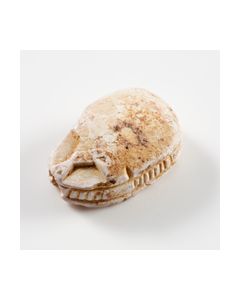 Skarabäussiegel mit schematischen Hieroglyphen
Skarabäussiegel mit schematischen HieroglyphenStempel mit schmatischen Hieroglyphen in Zierband, möge Re aufblühen. 15. bis 16. Dynastie des Alten Ägypten,Zeit der Hyksos-Fremdherrschaft.
Price: on request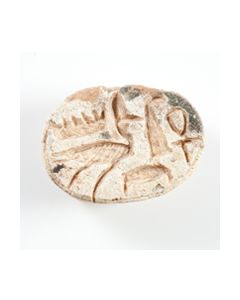 Skarabäus aus der Hyksos-Zeit
Skarabäus aus der Hyksos-ZeitStempel mit hieroglyphischer Inschrift, Anch, Maat-Feder, darunter das Gold-Zeichen und Sohn des Amun. 13. bis 18. Dynastie des Alten Ägypten, vermutlich 18. Dynastie.
Price: on request Ohrring aus Belutschistan, Indus-Kultur - Silber
Ohrring aus Belutschistan, Indus-Kultur - SilberAufwendig gearbeiteter, massiver Ohrring. In Verschlussnähe Verzierung durch Spiralwindungen. Museales Stück, tolle, dunkle Patina.
Price: on request Ägyptische Siegelfigur der Ersten Zwischenzeit
Ägyptische Siegelfigur der Ersten ZwischenzeitStempel in Form einer sitzenden Frau mit vier geometrischen Mäandermotiven. 7. bis 11. Dynastie des Alten Ägypten. Museumswürdig.
Price: on request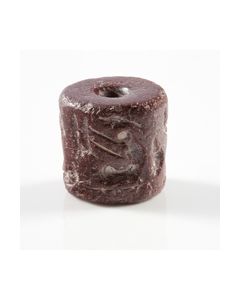 Vorderasiatisches Zylindersiegel
Vorderasiatisches ZylindersiegelAbrollung zeigt Szene sitzender Figuren. Möglicherweise eine Darstellung von Textilarbeitern. Uruk-Zeit bis Jemdet Nasr-Zeit.
Price: on request Steinperlen aus sumerischer Zeit
Steinperlen aus sumerischer ZeitScheibenperlen aus hellem Stein, zentrale Bohrung. Aus sumerischer Zeit, 4. bis 3. Jt. v. Chr. Ca. 13 bis 17mm Durchmesser.
Price: on request Krug aus Terracotta, Kanaan
Krug aus Terracotta, KanaanBronzezeit, Levante. Höhe 150mm, Durchm. 95mm, Oben 29mm, Öffnung 16mmHenkelöffnung 28x19mm. An Öffnung winzige Stelle abgebrochen, ansonsten ganz. Sehr imposant
Price: on request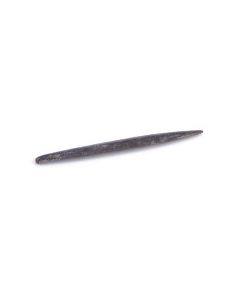 Pfeilspitze, Bronze (D)
Pfeilspitze, Bronze (D)Levante, mittlere bis späte Bronzezeit. 5,6cm lang.
Price: on request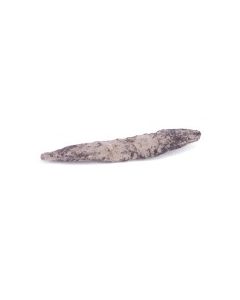 Pfeilspitze, Bronze (E)
Pfeilspitze, Bronze (E)Levante, mittlere bis späte Bronzezeit. 6,0cm lang.
Price: on request Bemaltes Tongefäß, Levante
Bemaltes Tongefäß, LevanteFrühe Bronzezeit, 3 Jt.v.Chr., dekorativ bemalt. 10cm hoch, 6cm Durchmesser. Perfekt erhalten.
Price: on request Krug aus Terracotta, Kanaan
Krug aus Terracotta, Kanaan1000 bis 500 v.Chr., Levante. Höhe 225mm, Durchm. 160mm. Komplett unbeschädigter Krug aus der Eisenzeit.
Price: on request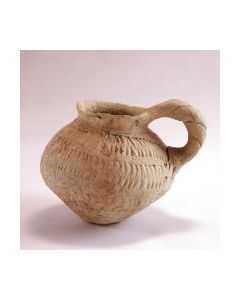 Kanaanitische Fingernagel Keramik
Kanaanitische Fingernagel KeramikSehr seltene kanaanitische Fingernagel-verzierte Keramik. 3. Jt.v.Chr. 7cm hoch. Perfekt erhalten.
Price: on request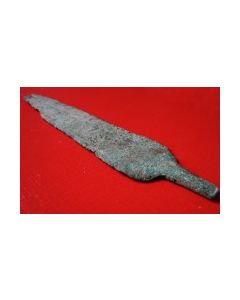 Klinge von Dolch oder Schwert (155)
Klinge von Dolch oder Schwert (155)Mittlere bis späte Bronzezeit, 1800 - 1200 v.Chr., Levante. Klinge 170mm, Griff 28mm, Breite am Griff 38mm, vorne ca 16mm, Griffstärke ca 3mm, Klinge ca 2mm.
Price: on request Pfeilspitze, Bronze (A)
Pfeilspitze, Bronze (A)Levante, mittlere bis späte Bronzezeit. 5,1 cm lang.
Price: on request Pfeilspitze, Bronze (C)
Pfeilspitze, Bronze (C)Levante, mittlere bis späte Bronzezeit. 6,4cm lang.
Price: on request Ägyptisches Skarabäus Siegel
Ägyptisches Skarabäus Siegel12. Dynastie, 13mm lang. Kleine Beschädigung an Unterseite.
Price: on request Ägyptisches Skarabäus Siegel
Ägyptisches Skarabäus Siegel18. bis 26. Dynastie, 13mm lang. Hieroglyphische Abbildung von Ibisvogel und Rascheibe.
Price: on request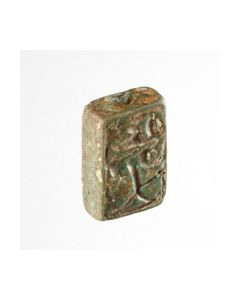 Ägyptisches Plättchen mit Kartusche des Sethos I.
Ägyptisches Plättchen mit Kartusche des Sethos I.Doppelseitige Platte aus grüner Fayence aus dem Neuen Reich, ramessidisch, um 1290 v. Chr. Sphinx und Kartusche (Men-Maat-Re) und Namens-Kartusche mit dem Eigennamen Meri-en-Ptah.
Price: on request Skarabäus mit Kartusche des Chaneferre
Skarabäus mit Kartusche des ChaneferreSkarabäus mit Namens-Kartusche des Königs Chaneferre (Sobekhotep IV.). 13. Dynastie des Alten Ägyptens, ca. 1700-1680 v. Chr.
Price: on request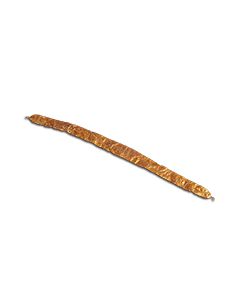 Mycenaean gold diadem
Mycenaean gold diademDelicate piece of ancient jewelry made of gold foil
Price: on request Cowroid with magical anra formula
Cowroid with magical anra formulaThe bottom side hieroglyphs of the anra type are to be interpreted as magical formula. The amulet dates to the Second Intermediate Period of ancient Egpyt.
Price: on request Scarab with cartouche of Thutmose III.
Scarab with cartouche of Thutmose III.Amulet from the New Kingdom for one of the most popular rulers in ancient Egyptian history. This scarab is described in the catalogue of Irène Gautier-Vodoz.
Price: on request Scarab with sphinx
Scarab with sphinxThe stamp depicts a human headed sphinx walking towards the Ankh symbol of life. The amulet should exert a protective function on the one carrying or owning it.
Price: on request Scarab with falcon headed god
Scarab with falcon headed godInteresting scarab amulet from the Second Intermediate Period. The seal shows a falcon headed creature facing an Egyptian cobra. This scarab can be found in the catalogue of Irène Gautier-Vodoz.
Price: on request Scarab from the Second Intermediate Period
Scarab from the Second Intermediate PeriodThe lower side shows a scarab, flanked by two uraeus snakes. 13th to 15th dynasty of ancient Egpyt. This scarab is described in the catalogue of Irène Gautier-Vodoz.
Price: on request Scarab with hieroglyphs arranged in a pattern
Scarab with hieroglyphs arranged in a patternThe lower side is skillfully decorated with hieroglyphs forming a geometric pattern. This scarab is described in the catalogue of Irène Gautier-Vodoz.
Price: on request Scarab with sphinx
Scarab with sphinxThe stamp depicts a sphinx with pharaoh headcloth walking towards the Ankh symbol of life. The amulet should exert a protective function on the one carrying or owning it.
Price: on request Scarab with the Red Crown of Lower Egypt
Scarab with the Red Crown of Lower EgyptThe scene can be seen as worship of the Deshret, the symbol of the kings of Lower Egypt during Hyksos times. An interesting piece of evidence of the Hyksos rule over Egypt.
Price: on request Egyptian scarab with papyrus plants
Egyptian scarab with papyrus plantsScarab amulet made of bright, almost white steatite. 13th to 15th dynasty. This scarab is described in the catalogue of Irène Gautier-Vodoz.
Price: on request Egyptian faience ring showing Bes and Taweret
Egyptian faience ring showing Bes and TaweretThe finger ring with its scene on the plate must have served a protective function for an expectant mother. New Kingdom, approx. 1550 to 1070 BC.
Price: on request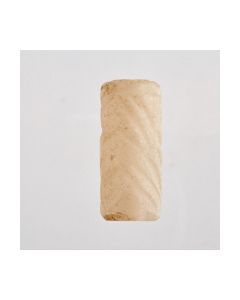 Mesopotamian cylinder seal with abstract scene
Mesopotamian cylinder seal with abstract sceneThe milky white stone is engraved with a scene that stands out by its high degree of abstraction. Late Uruk to Djemdet Nasr period, around 3000 BC.
Price: on request Mesopotamian cylinder seal with fighting scene
Mesopotamian cylinder seal with fighting sceneThe scene shows a fight between hero and lion with animals. Early Dynastic Period III, around 2500 BC.
Price: on request Akkadian cylinder seal of shell core
Akkadian cylinder seal of shell coreTwo lions are fighting with two buffalos. The balance and detail of the scene is an impressive demonstration of the Akkadian seal engraver's skill. Old Akkadian, around 2300 BC.
Price: on request Elamite vessel with painted frieze
Elamite vessel with painted friezeImpressive ceramic jar in prime condition. The geometrical shapes and animals of the frieze are a typical stylistic feature. Found in Susa, from the time of the Ur-III dynasty, around 2000 BC.
Price: on request Scarab with geometric motive
Scarab with geometric motiveThe lower side exhibits wrapped cords. A nice example of Egyptian art during the Second Intermediate Period. This scarab is described in the catalogue of Irène Gautier-Vodoz.
Price: on request

